|
|
Violations in Valley Zones and Buffer Zones of Water Bodies
Solution: evict all encroachments to restore and maintain hydrological integrity of valley zones and flood plains
Valley zones: Bangalore has the distinction of having inter connected lake systems. Valley zones connecting two lakes are to be protected to ensure the continuation of hydrological functions of the drains and flood plains. These have been designated as sensitive regions as per the revised master plan 2015 (RMP 2015 of BDA). However, valley zones in Bangalore are being abused despite norms to protect these fragile ecosystems. For example, Pristine Bellandur-Varthur wetland ecosystem has been experiencing threat due to the large scale catchment alterations with changes in the land use land cover. The region forms a part of primary valley, which is sensitive regions as per the revised master plan 2015 (RMP 2015 of BDA). The landscape forms an integral part of the protected area (as it is in valley zone) as per the CDP 2015. This wetlands is now being converted with mixed land use i.e., Built-up with both residential and office complexes. Alterations in the wetland began in 2004 and aggravated post 2008. The alterations of these wetlands initiated by filling the low lying areas with excavated earth debris, followed by other construction activities. The land fillings have breached both rajakaluve and lakes. Rajakaluve have reduced in width from as high as 35m to less than 8 m, apart from the loss of natural stream network connecting the lakes and rajakaluveys. Major violations in Bellandur-Vathur wetlands are:
- LAND USE CHANGES WITH THE CONSTRUCTION ACTIVITIES IN THE PRIMARY VALLEY – SENSITIVE REGIONS (as per RMP, 2015 of BDA: The region is located in the primary valley of the Koramangala Challaghatta valley. Primary valleys in Bangalore are sensitive regions as per sensitive zone notification - Circular/35/BBMP/2008, dated: 26/11/2008) and buffer zone for primary valley is 100 m.
- The region is a wetland as per KARNATAKA LAKE CONSERVATION AND DEVELOPMENT AUTHORITY ACT, 2014 - KARNATAKA ACT NO. 10 OF 2015; KAR. ACT 12, pg 462; National Wetland Atlas, SAC Ahmedabad, 2009; Wetland rules, MoEF, Govt of India, 2010, 2016; RAMSAR Definition of wetlands.
- Removal of wetlands affects Intergeneration Equity.
- Depriving local residents of water: Wetlands helps in recharge of groundwater in the region.
- Encroachment of Rajakalve and streams (connecting Bellandur and Varthur lakes).
- Deprives local residents of clean, air and water (as per Article 21 of the Constitution of India).
- Dumping of building debris and excavated earth in Wetlands and also in water-spread area of Bellandur and Varthur lake.
- Encroachment of Bellandur and Varthur lake.
Figure 5.1 depicts the landscape dynamics in the valley zone between Bellandur and Varthur Lakes. Large scale landscape changes found to occur since 2004, and the process of urbanization is occurring from west to east (Bellandur to Varthur). The wetlands and agriculture lands encompassing 98.5% of the valley zone in 2002 have drastically decreased to 25.68% by the year 2016 which is due to land use conversion for construction (residential/commercial/infrastructure) which has increased from 1.44% in 2002 to 74.32% in 2016. This rampant growth in the valley zone have removed lakes and raja kaluveys that altered the function of natural system of cleansing water, recharging ground water. Table 5.1 highlights extent of landscape alterations and unauthorized occupation of Valley zone.
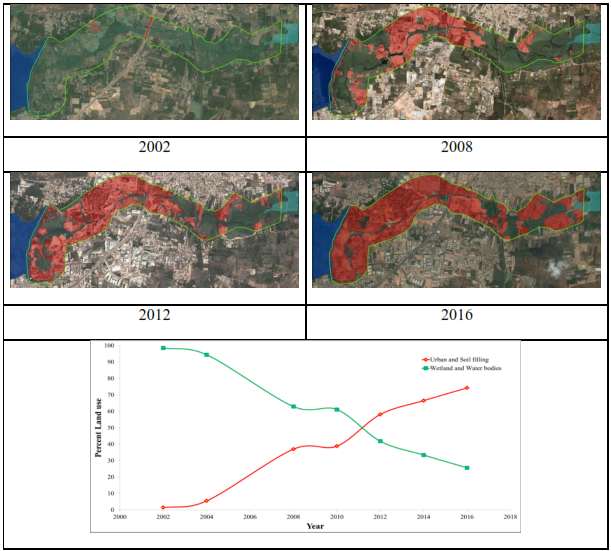
Figure 5.1: Land use dynamics in Bellandur Varthur Valley Zone
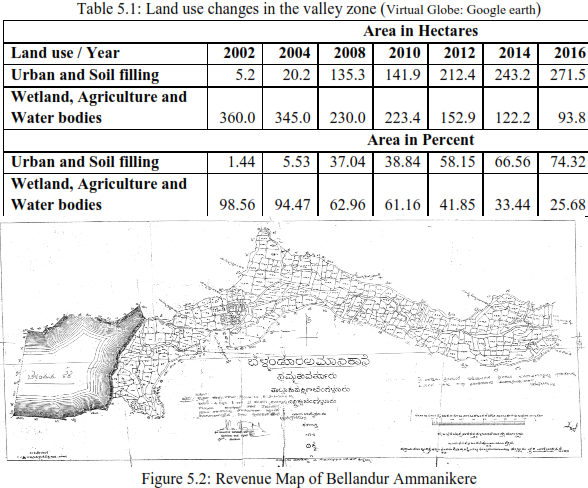
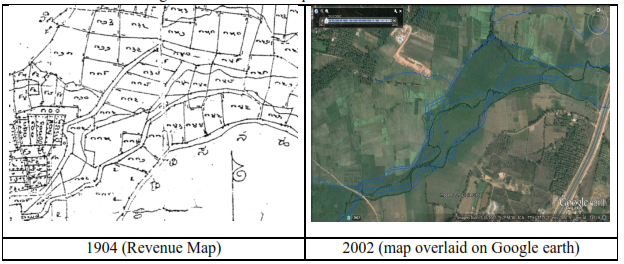
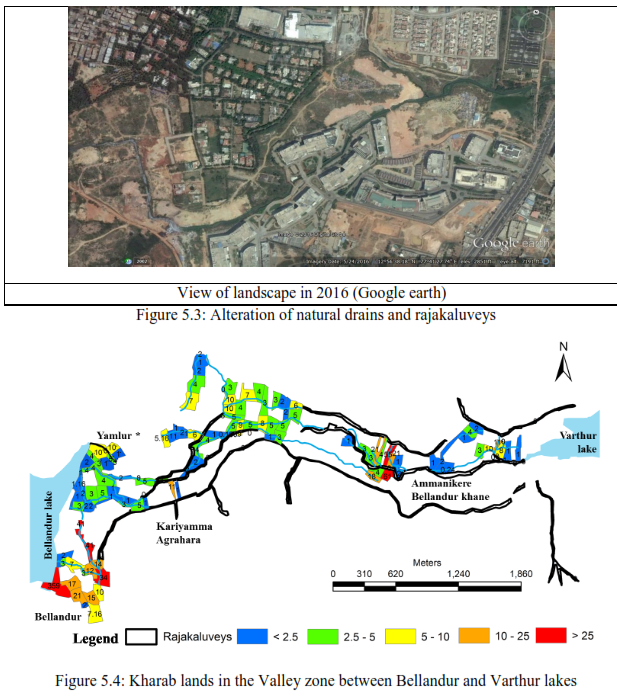
Table 5.2: Kharab lands in the valley zone
Ammanikere Bellandur Khane |
Survey Number |
Area (Gunta) |
Survey Number |
Area (Gunta) |
Survey Number |
Area (Gunta) |
2 |
1 |
98 |
2 |
168 |
3 |
3 |
1.16 |
99 |
1 |
169 |
2 |
6 |
4 |
106 |
4 |
170 |
2 |
7 |
4 |
107 |
2 |
171 |
6 |
8 |
1 |
108 |
2 |
172 |
5 |
9 |
1 |
116 |
4 |
201 |
1 |
10 |
5 |
117 |
1 |
209 |
3 |
11 |
3 |
120 |
6 |
212 |
3 |
12 |
2 |
124 |
7 |
213 |
21 |
13 |
2 |
125 |
4 |
215 |
4 |
14 |
2 |
126 |
2 |
217 |
4 |
15 |
3 |
127 |
1 |
218 |
18 |
16 |
1 |
128 |
2 |
221 |
61 |
25 |
2 |
140 |
5 |
222 |
21 |
26 |
3 |
141 |
5 |
223 |
55 |
27 |
7 |
142 |
0.16 |
227 |
1 |
30 |
12 |
145 |
9 |
228 |
2 |
31 |
3 |
148 |
5 |
241 |
1 |
38 |
34 |
151 |
4 |
244 |
1 |
39 |
14 |
152 |
10 |
245 |
2 |
42 |
41 |
153 |
10 |
248 |
2 |
53 |
3 |
154 |
3 |
249 |
4 |
54 |
1 |
157 |
7 |
250 |
1 |
55 |
5 |
159 |
4 |
253 |
0.24 |
56 |
1 |
160 |
3 |
256 |
14.08 |
63 |
5 |
161 |
8 |
272 |
10 |
64 |
2 |
162 |
5 |
273 |
3 |
93 |
5.16 |
163 |
1 |
280 |
11 |
94 |
2 |
164 |
3 |
282 |
8 |
96 |
1 |
165 |
5 |
283 |
1 |
97 |
1 |
166 |
2 |
285 |
1 |
Total Area (Guntas) |
570.8 |
Total Area (Acres) |
14.27 |
|
Bellandur |
Yamlur * |
Kariyamma Agrahara |
Survey Number |
Area (Gunta) |
Survey Number |
Area (Gunta) |
Survey Number |
Area (Gunta) |
4 |
359 |
54 |
20 |
17 |
4 |
8 |
17 |
55 |
1 |
19 |
11 |
10 |
10 |
56 |
10 |
22 |
1 |
11 |
15 |
57 |
1 |
Total (Gunta) |
16 |
13 |
21 |
58 |
3 |
Total(Acre) |
0.4 |
14 |
2 |
59 |
4 |
|
|
18 |
7.16 |
60 |
2 |
|
|
Total (Gunta) |
431.16 |
Total (Gunta) |
41 |
|
|
Total(Acre) |
10.78 |
Total(Acre) |
1.025 |
|
|
* Verification required |
Total Area (Guntas) |
1058.96 |
Total Area (Acres) |
26.47 |
Figure 5.2 depicts the revenue map of Bellandur Varthur valley zone (Bellandur Ammanikere). Rampant landscape changes in the valley zone have reduced the width (Figure 5.3) or encroached the natural drainages and rajakaluveys. Rajakaluveys of 25m to 35 m width have reduced in width to less than 5m to 8 m ( example is depicted in Figure 5.9). Figure 5.4 and Table 5.2 details kharab lands in the valley zone between Bellandur and Varthur lake. 1058.96 Guntas (26.47 Acres) of land in the valley zone falls under the category of kharab lands and is distributed in villages of Ammanikere Bellandur Khane, (570.8 Guntas), Bellandur (431.2 Guntas), Kariyamma Agrahara (16 Guntas), Yamlur* (41 Guntas).
Bellandur-Agaram Valley zone: Figure 5.5 depicts the landscape dynamics during 2000 to 2015 (mapped on temporal Google Earth data – http://earth.google.com). The remote sensing data of 2009 – 2015 substantiates the unabated construction activities in the valley zone (without proper compliance and gross violations of environmental norms). Table 5.4 highlights extent of landscape alterations and unauthorized occupation of wetlands (Agara-Bellandur wetland). Figure 5.6 gives cadastral map (1904, scale: 1 in 7920) of the region with land uses - drainage network, agriculture land parcels, tank boundaries, etc.
Table 5.4: Extent of encroachment and illegalities
Year |
wetland |
2007 |
63 Acres 37.5 Guntas |
2010 |
66 Acres 32.3 Guntas |
2012 |
72 Acres 15.9 Guntas |
2013 |
74 Acres 12.1 Guntas |
2015 |
74 Acres 12.1 Guntas |
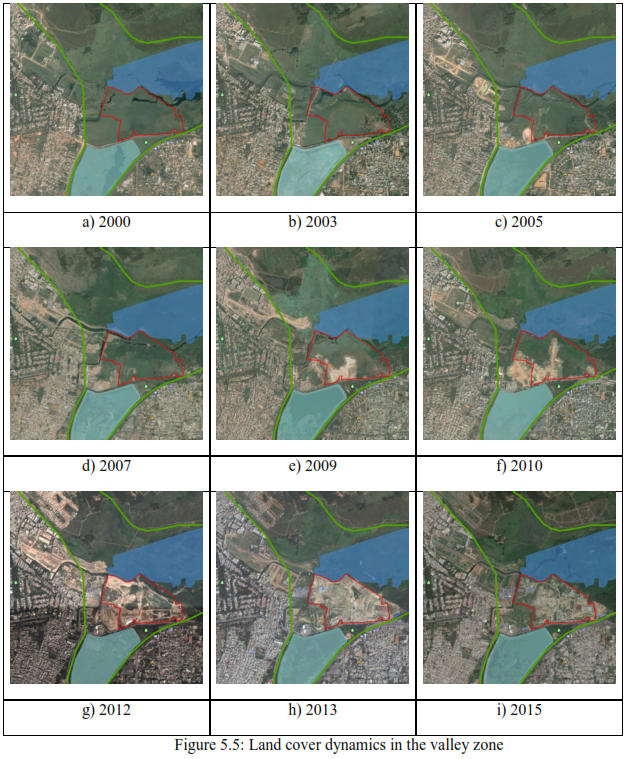
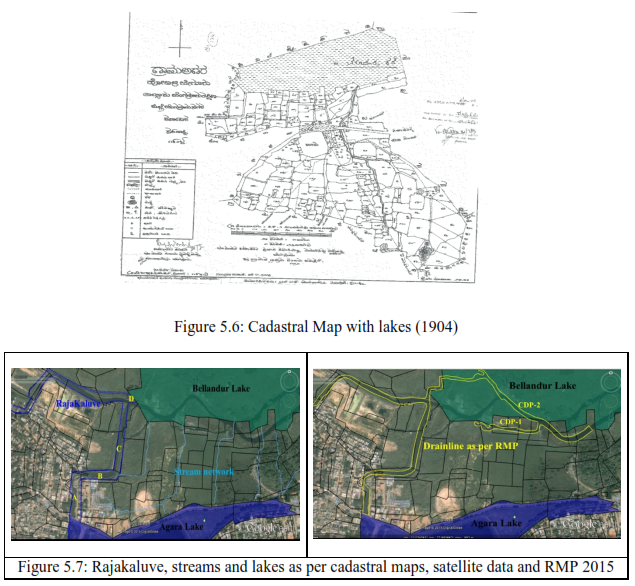
Figure 5.7 highlights interconnected lake system in Agara-Bellandur region with rajakaluves and stream network. Figure 5.7 also indicates the narrowing down of rajakaluves for the period 2000 to 2015, (for the cross sections A, B, C, D). Rajakauluves have declined between 23% and 57% of the original width during the year 2000 to 2015. Table 5.5 lists applicable various norms for wetlands conservation.
Table 5.5: Various norms for lakes and rajakaluve conservation
Activities around lakes |
Norms to protect and conserve Wetlands |
Encroachment of lake bed and loss of interconnectivity among
lakes |
The Hon’ble Supreme Court in Civil appeal number 1132/2011 at SLP (C) 3109/2011 on January 28,2011 has expressed concern regarding encroachment of common property resources, more particularly lakes (and raja kaluves) and it has directed the state governments for removal of encroachments on all community lands.
Eviction of encroachment: Need to be evicted as per Karnataka Public Premises (eviction of unauthorised occupants) 1974 and the Karnataka Land Revenue Act, 1964 |
Buildings in the buffer zone of lakes |
In case of water bodies, 75.0 m buffer of ‘no development zone’ (as per recent National Green Tribunal direction) is to be maintained around the lake (buffer region to be as per revenue records)
- As per BDA, RMP 2015 (Regional Master Plan, 2015)
- Section 17 of KTCP (Karnataka Town and Country Planning) Act, 1961 and sec 32 of BDA Act, 1976
- Wetlands (Conservation and Management) Rules 2010, Government of India; Wetlands Regulatory Framework, 2008.
|
Construction activities in the valley zone (SEZ by Karnataka Industrial Areas Development Board (KIADB)) in the valley zone |
This is contrary to sustainable development as the natural resources (lake, wetlands) get affected, eventually leading to the degradation/extinction of lakes. This reflects the ignorance of the administrative machinery on the importance of ecosystems and the need to protect valley zones considering ecological function and these regions are ‘NO DEVELOPMENT ZONES’ as per CDP 2005, 2015 |
Alterations in topography |
Flooding of regions would lead to loss of property and human life and, spread of diseases. |
Increase in deforestation in catchment area |
Removing vegetation in the catchment area increases soil erosion and which in turn increases siltation and decreases transpiration |
Documentation of biodiversity |
- The biodiversity of every water body should form part of the School, College, People’s Biodiversity Registers (SBR, CBR, PBR).
- The local Biodiversity Management Committees (BMC) should be given necessary financial support and scientific assistance in documentation of diversity.
- The presence of endemic, rare, endangered or threatened species and economically important ones should be highlighted
- A locally implementable conservation plan has to be prepared for such species
|
Implementation of sanitation facilities |
- The lakes are polluted with sewage, coliform bacteria and various other pathogens
- Preserving the purity of waters and safeguarding the biodiversity and productivity, dumping of waste has to be prohibited
- All the settlements alongside the water body should be provided with sanitation facilities so as not to impinge in anyway the pristine quality of water
|
Violation of regulatory and prohibitory activities as per Wetlands (Conservation and Management) Rules, 2016 and 2010;
Regulatory wetland framework, 2008 |
Environment Impact Assessment (EIA) Notification, 2009.
Wetlands (Conservation and Management) rules 2010, Government of India; Regulatory wetland framework, 2008
Regulated activity
- Withdrawal of water/impoundment/diversion/interruption of sources
- Harvesting (including grazing) of living/non-living resources (may be permitted to the level that the basic nature and character of the biotic community is not adversely affected)
- Treated effluent discharges – industrial/ domestic/agro-chemical.
- Plying of motorized boats
- Dredging (need for dredging may be considered, on merit on case to case basis, only in cases of wetlands impacted by siltation)
- Constructions of permanent nature within 50 m of periphery except boat jetties
- Activity that interferes with the normal run-off and related ecological processes – up to 200 m
Prohibited activity
- Conversion of wetland to non-wetland use
- Reclamation of wetlands
- Solid waste dumping and discharge of untreated effluents
|
Damage of fencing, solid waste dumping and encroachment problems in Varthur lake series
|
High Court of Karnataka (WP No. 817/2008) had passed an order which include:
- Protecting lakes across Karnataka,
- Prohibits dumping of garbage and sewage in Lakes
- Lake area to be surveyed and fenced and declare a no development zone around lakes
- Encroachments to be removed
- Forest department to plant trees in consultation with experts in lake surroundings and in the watershed region
- Member Secretary of state legal services authority to monitor implementation of the above in coordination with Revenue and Forest Departments
- Also setting up district lake protection committees
|
Polluter Pays principle |
National Environment Policy, 2006
The principal objectives of NEP includes :
- Protection and conservation of critical ecological systems and resources, and invaluable natural and man-made heritage
- Ensuring judicious use of environmental resources to meet the needs and aspirations of the present and future generations
- It emphasizes the “Polluter Pays” principle, which states the polluter should, in principle, bear the cost of pollution, with due regard to the public interest
|
Prevention of pollution of lake |
National Water Policy, 2002
Water is a scarce and precious national resource and requires conservation and management.
Watershed management through extensive soil conservation, catchment-area treatment, preservation of forests and increasing the forest cover and the construction of check-dams should be promoted.
The water resources should be conserved by retention practices such as rain water harvesting and prevention of pollution. |
Discharge of untreated sewage into lakes |
The Environment (Protection) Act, 1986
- Lays down standards for the quality of environment in its various aspects
- Laying down standards for discharge of environmental pollutants from various sources and no persons shall discharge any pollutant in excess of such standards
- Restriction of areas in which industries, operations or processes shall not be carried out or carried out subject to certain safeguards
|
The water pollution, prevention and its control measures were not looked upon |
Water (Prevention and Control of Pollution) Act, 1974
- It is based on the “Polluter pays” principle.
The Pollution Control Boards performs the following functions :
- Advice the government on any matter concerning the prevention and control of water pollution.
- Encourage, conduct and participate in investigations and research relating to problems of water pollution and prevention, control or abatement of water pollution.
- Inspects sewage and effluents as well as the efficiency of the sewage treatment plants.
- Lay down or modifiy existing effluent standards for the sewage.
- Lay down standards of treatment of effluent and sewage to be discharged into any particular stream.
- Notify certain industries to stop, restrict or modify their procedures if the present procedure is deteriorating the water quality of streams.
|
Pathetic water scenario and insufficient drinking water in Bangalore |
The depletion of ground water and drying up off lakes has affected the water availability to meet the current population. At the 4% population growth rate of Bangalore over the past 50 years, the current population of Bangalore is 8.5 million (2011). Water supply from Hesaraghatta has dried, Thippagondanahalli is drying up, the only reliable water supply to Bangalore is from Cauvery with a gross of 1,410 million liters a day (MLD). There is no way of increasing the drawal from Cauvery as the allocation by the Cauvery Water Disputes Tribunal for the entire urban and rural population in Cauvery Basin in Karnataka is only 8.75 TMC ft (one thousand million cubic – TMC ft equals 78 MLD), Bangalore city is already drawing more water-1,400 MLD equals 18 TMC—than the allocation for the entire rural and urban population in Cauvery basin |
KLCDA Act 2014 |
Acts prohibited in lakes
(1) use the lake for any purpose other than storage or impounding of water or for the purpose mentioned in clause (9) of section 5;
(2) construct any structure on lake land, occupy any lake land or part thereof or cause any obstruction at the natural or normal course of inflow or outflow of water into, or from, the lakes on the upstream and or downstream;
(3) construct any commercial, recreational or industrial complexes or houses or carry on any industrial activity within the distance to be notified by the Government depending on the water spread area of the lake;
(4) dump debris, municipal solid wastes, mud or earth soil or liquid wastes or any pollutants, into the lake by using vehicle or otherwise;
(5) discharge untreated sewage into the lake directly or indirectly;
(6) construct roads, bridges and likewise other structures within the lake area including the tank bund;
(7) breach bund, waste weir including lowering the height of the waste weir from its original height or remove fence, boundary stones or any hoarding or any sign board erected by the Authority; and
(8) do any other act which is detrimental directly or indirectly to the lakes. |
References:
- Ramachandra T V, Vinay S, Bharath H. Aithal, 2017. Koramangala Floods: Causes, ENVIS Technical Report 131, Environmental Information System, CES, Indian Institute of Science, Bangalore 560012
- Sudarshan Bhat, Mahesh M K and Ramachandra T V, 2017. Macrophytes of Bangalore Wetlands, ENVIS Technical Report 126, Energy & Wetlands Research Group, CES, Indian Institute of Science, Bangalore 560012
- Ramachandra T V, Sudarshan Bhat and Vinay S, 2017. Constructed Wetlands for Tertiary treatment of Wastewater, ENVIS Technical Report 124, Energy & Wetlands Research Group, CES, Indian Institute of Science, Bangalore 560012
- Ramachandra T V, Vinay S, Bharath H. Aithal, 2017. Frequent Floods in Bangalore: Causes and Remedial Measures, ENVIS Technical Report 123, Environmental Information System, CES, Indian Institute of Science, Bangalore 560012
- Ramachandra T.V., Durga Madhab Mahapatra, Sudarshan P. Bhat, Asulabha K.S., Sincy Varghese, Bharath H. Aithal, 2014. Integrated Wetlands Ecosystem: Sustainable Model to Mitigate Water Crisis in Bangalore, ENVIS Technical Report 76, Environmental Information System, CES, Indian Institute of Science, Bangalore 560012
- Ramachandra T V, Vinay S and Bharath H.Aithal, 2015. Detrimental landuse changes in Agara-Belllandur wetland, ENVIS Technical Report 95, CES, IISc, Bangalore, India
- Ramachandra T V, Asulabha K S, Sincy V, Vinay S, Bharath H.Aithal, Sudarshan P. Bhat, and Durga M. Mahapatra, 2015. Pathetic status of wetlands in Bangalore: Epitome of inefficient and uncoordinated Governance, ENVIS Technical Report 93, CES, Indian Institute of Science, Bangalore 560012
- Ramachandra T V, Asulabha K S, Sincy V, Sudarshan Bhat and Bharath H.Aithal, 2015. Wetlands: Treasure of Bangalore, ENVIS Technical Report 101, Energy & Wetlands Research Group, CES, IISc, Bangalore, India
- Ramachandra T V, Durga Madhab Mahapatra, Asulabha K S, Sincy Varghese, 2017. Foaming or Algal Bloom in Water bodies of India: Remedial Measures - Restrict Phosphate (P) based Detergents, ENVIS Technical Report 108, Environmental Information System, CES, Indian Institute of Science, Bangalore 560012
- Ramachandra T V, Vinay S, Durga Madhab Mahapatra, Sincy Varghese, Bharath H. Aithal, 2016. Water situation in Bengaluru, ENVIS Technical Report 114, Environmental Information System, CES, Indian Institute of Science, Bangalore 560012
- Ramachandra T V, Durga Madhab Mahapatra, Vinay S, Sincy V, Asulabha K S, Sudarshan Bhat, Bharath H. Aithal, 2017. Bellandur and Varthur Lakes Rejuvenation Blueprint, ENVIS Technical Report 116, Environmental Information System, CES, Indian Institute of Science, Bangalore 560012
- Ramachandra T V, Vinay S, Asulabha K S, Sincy V, Sudarshan Bhat, Durga Madhab Mahapatra, Bharath H. Aithal, 2017. Rejuvenation Blueprint for lakes in Vrishabhavathi valley, ENVIS Technical Report 122, Environmental Information System, CES, Indian Institute of Science, Bangalore 560012
- Ramachandra T V, Vinay S, Bharath H. Aithal, 2017. Frequent Floods in Bangalore: Causes and Remedial Measures, ENVIS Technical Report 123, Environmental Information System, CES, Indian Institute of Science, Bangalore 560012
- Ramachandra, T.V., Bharath H. A.,and Durgappa, D. S., Insights to urban dynamics through landscape spatial pattern analysis, Int. J Applied Earth Observation and Geoinformation, 2012,18,329-343,.
- Ramachandra, T.V., Bharath, H. A.and Sreejith, K., GHG footprint of major cities in India, Renewable and Sustainable Energy Reviews, 2015, 44,473–495
- Ramachandra, T.V., Bharath, H. A., Vinay, S., et al., Trees of Bengaluru, ENVIS Technical Report 75, ENVIS, Centre for Ecological Sciences, IISc, Bangalore, 2014. 75p.
Ramachandra T.V., Bharath H. Aithal, 2016. Bangalore’s Reality: towards unlivable status with unplanned urban trajectory, Current Science (Guest Editorial), 110(12):2207-2208, 25th June 20
|
Dr. T.V. Ramachandra
Centre for Sustainable Technologies, Centre for infrastructure, Sustainable Transportation and Urban Planning (CiSTUP), Energy & Wetlands Research Group, Centre for Ecological Sciences, Indian Institute of Science, Bangalore – 560 012, INDIA.
E-mail : tvr@iisc.ac.in
Tel: 91-080-22933099/23600985,
Fax: 91-080-23601428/23600085
Web: http://ces.iisc.ac.in/energy
Vinay SEnergy & Wetlands Research Group, Centre for Ecological Sciences, Indian Institute of Science, Bangalore – 560 012, INDIA.
E-mail: svinay@iisc.ac.in
Sudarshan BhatEnergy & Wetlands Research Group, Centre for Ecological Sciences, Indian Institute of Science, Bangalore – 560 012, INDIA.
E-mail: sudarshanb@iisc.ac.in
Bharath SetturEnergy & Wetlands Research Group, Centre for Ecological Sciences, Indian Institute of Science, Bangalore – 560 012, INDIA.
E-mail: setturb@iisc.ac.in
Bharath H. AithalEnergy & Wetlands Research Group, Centre for Ecological Sciences, Indian Institute of Science, Bangalore – 560 012, INDIA.
E-mail: bharathh@iisc.ac.in
Citation:Ramachandra T V, Vinay S, Sudarshan Bhat, Bharath Settur, Bharath H. Aithal, 2017. Unabated Violations in Agara Bellandur Wetland, ENVIS Technical Report 134, Environmental Information System, CES, Indian Institute of Science, Bangalore 560012
| Contact Address : |
| |
Dr. T.V. Ramachandra
Energy & Wetlands Research Group,
Centre for Ecological Sciences, TE 15, New Biology Building, Third Floor, E Wing, [Near D Gate], Indian Institute of Science, Bangalore – 560 012, INDIA.
Tel : 91-80-22933099 / 22933503-extn 107
Fax : 91-80-23601428 / 23600085 / 23600683 [CES-TVR]
E-mail : tvr@iisc.ac.in, energy@ces.iisc.ac.in,
Web : http://wgbis.ces.iisc.ac.in/energy |
|